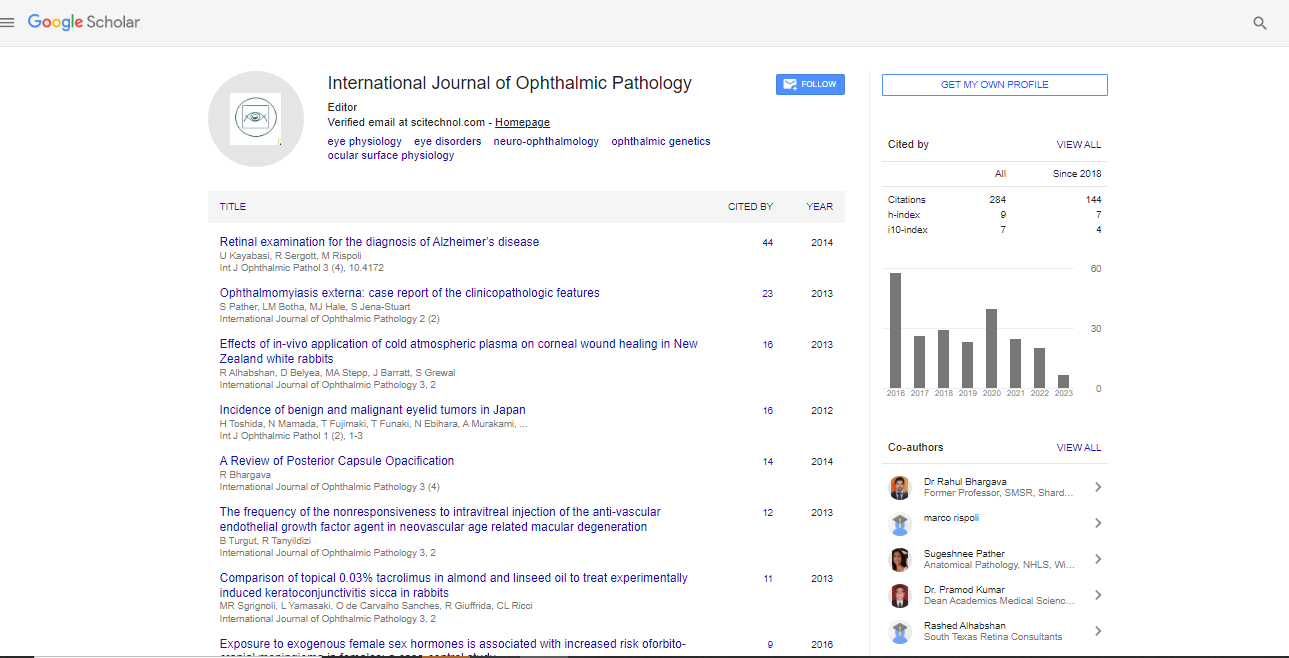Perspective, Int J Ophthalmic Pathol Vol: 0 Issue: 0
Treatment for Increasing Myopia in Children
Afreen Begum*
Department of Biotechnology, Shreyas Institute of Pharmaceuticals, Hyderabad, India.
*Corresponding Author:
Afreen Begum
Department of Biotechnology, Shreyas Institute of Pharmaceuticals, Hyderabad, India.
E-mail: Afreenbegum3@gmail.com
Received: July 06, 2021 Accepted: July 20, 2021 Published: July 27, 2021
Citation: Begum A (2021) Treatment for Increasing Myopia in Children. Int J Ophthalmic Pathol 10:7. (292)
Abstract
During childhood, nearsightedness (partial blindness) is regularly treated with glasses or contact focal points. Refractive medical procedure, like LASIK or PRK, is ordinarily utilized in grown-ups once the glasses remedy is done evolving. In reformist nearsightedness, the astigmatism regularly starts in youth, and deteriorates as the kid develops
Keywords: Nearsightedness , Blindness
Introduction
During childhood, nearsightedness (partial blindness) is regularly treated with glasses or contact focal points. Refractive medical procedure, like LASIK or PRK, is ordinarily utilized in grown-ups once the glasses remedy is done evolving. In reformist nearsightedness, the astigmatism regularly starts in youth, and deteriorates as the kid develops. Numerous patients and families ask regarding why nearsightedness increments and need to know whether there are approaches to back it off.
Description
There is a solid hereditary segment to nearsightedness, so if either parent is astigmatic, the youngster is bound to become myopic. Some enormous investigations have noticed that youngsters who invest more energy outside are more averse to foster nearsightedness. The specific explanation is indistinct, yet it is felt that openness to daylight might be helpful. Different investigations have proposed that a ton of close to work at a youthful age might be unsafe. Numerous treatment choices have been investigated to attempt to moderate the pace of expanding nearsightedness. Current ideas include: • Low dose atropine eye drops Various investigations worldwide have shown that low portions of atropine eye drops can moderate the increment in nearsightedness, however it is hazy how. Atropine eye drops are expanding eye drops normally utilized after eye a medical procedure, eye injury, or eye aggravation and are likewise utilized in amblyopia therapy in kids. For these reasons, the financially accessible portion is 1% atropine; however this portion normally brings about huge enlargement of the understudy, light affectability, and obscured vision at close. Later examination has been centered around utilizing lower portions of atropine eye drops to diminish the incidental effects brought about by this medicine. The lower portion of 0.01% atropine has reliably been demonstrated to be successful at diminishing the pace of expanding nearsightedness, with less incidental effects contrasted with the higher dosages of atropine (i.e., less to no light affectability and obscured close to vision). While past examinations have shown that halting the higher (1%) portion of atropine can bring about a bounce back impact (critical declining or expansion in nearsightedness after the eye drop was halted), this impact was noted to be less subsequent to halting the lower portion of atropine. This utilization of atropine eye drops requires the utilization of eye drops each day, likely for no less than 1-2 years. Since this is a lower than typical portion of atropine, it requires an uncommon drug store to make the eye drops. There are at present a few continuous clinical examinations exploring low dosages of atropine to decide the best portion of atropine to use to moderate the increment in nearsightedness. Thus, the portion of atropine that you might be prescribed to utilize might be somewhere in the range of 0.01% and 1%. Contact lenses Multifocal contact focal points have additionally been assessed for hindering an increment in nearsightedness. Various kinds of multifocal contact focal points might be endorsed to attempt to hinder an increment in nearsightedness. In 2019, MiSight contact focal points turned into the primary FDA-endorsed treatment for nearsightedness control in the United States. These are an everyday dispensable contact focal point that should be fit by a strength prepared optometrist or ophthalmologist. Another less broadly suggested utilization of contact focal points for hindering an expansion in nearsightedness is called orthokeratology (otherwise called Ortho-K). Ortho-K includes utilizing inflexible gas penetrable contact focal points each night to reshape the unmistakable, forward portion of the eye (known as the cornea). A bounce back impact (where the nearsightedness increments in the wake of halting Ortho-K treatment) has been noted.
Conclusion
Dangers related with any contact focal point wear incorporate corneal scraped areas, ulcers or contaminations, and scarring that can prompt perpetual vision misfortune. • Increased time outdoors and away from electronic devices There has been expanding worry during the COVID-19 pandemic of expanded utilization of electronic gadgets because of far off realizing which may prompt an increment in nearsightedness. Studies have shown that openness to normal light outside can diminish the danger of creating nearsightedness and an increment in nearsightedness.
References
- Modjahedi BS. Abbott RL, Rong DS, Lum F, Tan D (2020)on behalf of the task force on Myopia. Reducing the global burden of myopia by delaying the onset of myopia and reducing myopic progression in children. Ophthalmol 1-11.
- Chamberlain P, Logan NS, Ngo C, Jones D, Young G (2019) A 3-year randomized clinical trial of MiSight lenses for myopia control. Optom Vis Sci. 98: 556-567.
- Jones LA, Sinnott LT, Mutti DO, Mitchell GL, Zadnik K (2007) Parental history of myopia, sports and outdoor activities, and future myopia. Invest Ophthalmol Vis Sci 48:3524-3532.
 Spanish
Spanish  Chinese
Chinese  Russian
Russian  German
German  French
French  Japanese
Japanese  Portuguese
Portuguese  Hindi
Hindi 